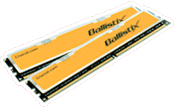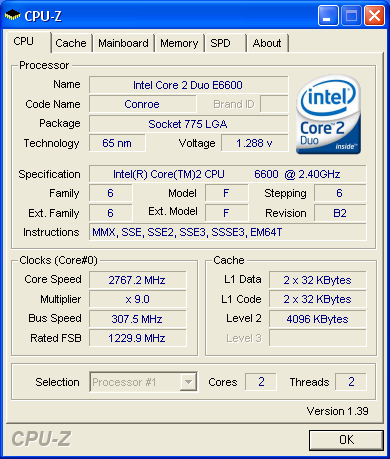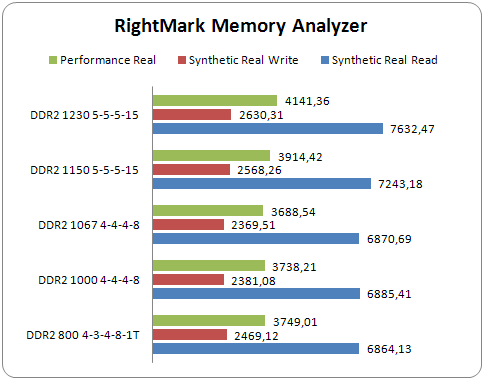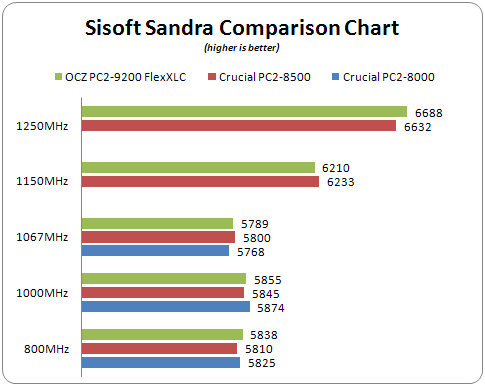1. Introduction
 Crucial, a division of Micron, produces quality memory modules for all categories of users. We had tested in the past their Ballistix PC2-8000, a DDR2 memory module that could run up to 1000MHz. Recently, Crucial announced a new, faster memory that can reach 1067MHz. How much faster is the new memory and how much higher can you overclock it, especially, compared with the "older" PC2-8000? We will find out in this review, but first, let's meet the Crucial Ballistix PC2-8500 series.
Crucial, a division of Micron, produces quality memory modules for all categories of users. We had tested in the past their Ballistix PC2-8000, a DDR2 memory module that could run up to 1000MHz. Recently, Crucial announced a new, faster memory that can reach 1067MHz. How much faster is the new memory and how much higher can you overclock it, especially, compared with the "older" PC2-8000? We will find out in this review, but first, let's meet the Crucial Ballistix PC2-8500 series.
- Crucial Ballistix BL2KIT12864AA1065 — The ultimate in gaming performance
 The Ballistix line is specifically built for performance enthusiasts who want to push the performance envelope without worrying about data loss or corruption, mysterious intermittent errors and display problems, or worse — the dreaded BSOD! The Ballistix line of high-performance memory modules features advanced speed grades, low latencies, and integrated aluminum heat spreaders.
The Ballistix line is specifically built for performance enthusiasts who want to push the performance envelope without worrying about data loss or corruption, mysterious intermittent errors and display problems, or worse — the dreaded BSOD! The Ballistix line of high-performance memory modules features advanced speed grades, low latencies, and integrated aluminum heat spreaders.

A Ballistix dual inline memory module (DIMM) consists of a number of memory components that are attached to a black printed circuit board. The gold pins on the bottom of the DIMM provide a connection between the module and a socket on a larger printed circuit board. The pins on the front and back of a DIMM are not connected to each other.
Ballistix 240-pin DIMMs are used to provide DDR2 SDRAM memory for desktop computers. Ballistix 240-pin DIMMs are available in DDR2 PC2-4200 SDRAM (DDR2 533), DDR2 PC2-5300 SDRAM (DDR2 667), DDR2 PC2-6400 (DDR2 800) and DDR2 PC2-8500 (DDR2 1067)
- Main features
- Module Size: 2GB kit (1GBx2)
- Package: Ballistix 240-pin DIMM
- Feature: DDR2 PC2-8500
- Configuration: 128Meg x 64
- DIMM Type: UNBUFFERED
- Error Checking: NON-ECC
- Speed: DDR2-1067
- Voltage: 2.2V
- Memory Timings: 5-5-5-15
- Retail package
Crucial provided us with the retail package consisting of 2x1GB of Ballistix PC2-8000 series. The retail price for the package is around US$380 and can be obtained directly from Crucial. The kit we received arrived at our labs in sealed antistatic plastic bags.



Removing the memory modules from the plastic bags, we have a clearer view. On both sides of the heatspreader, there are the "Crucial.com" and "Ballistix" logos. One side features the sticker with the part number and other manufacturing information.


2. Setup and Configuration
In order to test the memory modules, we used the following setup:
- CPU: Intel XE6600 @ 2.4GHz
- Motherboard: eVGA 680i LT
- PSU: OCZ GameXStream GXS600 SLI-Ready
- VGA: MSI 7600GT Silent (stock memory/core timings)
- HDD: WD 800JB
- OS: Windows XP SP2 with all the latest updates installed
While for benchmarking, we used:
- Memtest86+ v1.70
- Sisoft Sandra 2007 SP1
- RightMark Memory Analyzer v3.70
- ScienceMark 2.0 Memory Benchmark
- Pov-Ray v3.70 Beta15
- SuperPI XS Mod v1.50
The eVGA 680i LT motherboard offers many possibilities for overclocking both the memory and CPU, either synced or not. For most of our tests, we left the memory and CPU un-synced and tried to find the best possible memory timings. Each test before benchmarking, had to pass a 30min burn-in with Memtest86+ v1.70 (DOS), without producing any errors. Furthermore, we tried the Pov-Ray benchmark and Orthos Stability test under Windows to ensure that our system was rock solid. All benchmarks were then run twice for confirmation and all displayed results are the average from both measurements.
The SPD as reported by Everest Ultimate Edition are set only for 400 and 533MHz with CL4 and CL5 respectively:

The memory modules can work at even 1T with Nvidia based chipsets, for example @ 400MHz very low timings are possible, down to 4-3-4-8:

Lastly, here are the results for FSB and used voltage. In order to get low CL4 timings at 1067MHz, we had to use 2.30V memory voltage, and the highest DDR2 1230MHz, could only be achieved with 2.40V, rather high for a memory module. We tried to reach DDR2 1250MHz with 2.50V, but this produced many errors in the MemTest86+ test:

At DDR2 1230MHz, our CPU FSB and RAM were synced (1:1) and we overclocked the CPU up to 2.767GHz

Below are the memory timings as reported by CPU-Z :

3. SiSOFT Sandra - RightMark
 SiSoftware Sandra (the System ANalyser, Diagnostic and Reporting Assistant) is an information & diagnostic utility. It should provide most of the information (including undocumented) you need to know about your hardware, software and other devices whether hardware or software. It works along the lines of other Windows utilities, however it tries to go beyond them and show you more of what's really going on. Giving the user the ability to draw comparisons at both a high and low-level. You can get information about the CPU, chipset, video adapter, ports, printers, sound card, memory, network, Windows internals, AGP, PCI, PCIe, ODBC Connections, USB2, 1394/Firewire, etc.
SiSoftware Sandra (the System ANalyser, Diagnostic and Reporting Assistant) is an information & diagnostic utility. It should provide most of the information (including undocumented) you need to know about your hardware, software and other devices whether hardware or software. It works along the lines of other Windows utilities, however it tries to go beyond them and show you more of what's really going on. Giving the user the ability to draw comparisons at both a high and low-level. You can get information about the CPU, chipset, video adapter, ports, printers, sound card, memory, network, Windows internals, AGP, PCI, PCIe, ODBC Connections, USB2, 1394/Firewire, etc.
Sisoft Sandra offers two tests, buffered and un-buffered. We summed the two results and divided by two to get the average.

 Before this test packet was created there was no proper software for measuring vital system parameters such as CPU/Chipset/RAM providing steady and reliable (reproducible) test results and allowing for changing test parameters in a wide range.
Before this test packet was created there was no proper software for measuring vital system parameters such as CPU/Chipset/RAM providing steady and reliable (reproducible) test results and allowing for changing test parameters in a wide range.
Vital low-level system characteristics include latency and real RAM bandwidth, average/minimal latency of different cache levels and its associativity, real L1-L2 cache bandwidth and TLB levels specs. Besides, these aspects are usually not paid sufficient attention in product technical documentation (CPU or chipset). Such test suite, which combines a good deal of subsets aimed at measuring objective system characteristics, is a must have for estimating crucial objective platform parameters.
RightMark offers a variety of tests, including both read and write performance from synthetic and performance tests:

4. Science Mark - SuperPi
Science Mark 2.0 is an attempt to put the truth behind benchmarking. In an attempt to model real world demands and performance, SM2 is a suite of high-performance benchmarks that realistically stress system performance without architectural bias. Science Mark 2.0 is comprised of 7 benchmarks, each of which measures a different aspect of real world system performance.

SuperPI has become a utility to benchmark modern systems. In August 1995, the calculation of pi up to 4,294,960,000 decimal digits was succeeded by using a supercomputer at the University of Tokyo. The program was written by D.Takahashi and he collaborated with Dr. Y.Kanada at the computer center, the University of Tokyo. This record-breaking program was ported to personal computer environment such as Windows NT and Windows 95 and called Super PI.

The software offers up to 32M calculations of PI numbers. For all memory settings, we tested only up to 2M calculations.

5. Comparison Results
In order to compare the performance of the Crucial PC2-8500, we used two other memory modules from OCZ and Crucial.



The test results showed that at the 3 lowest frequencies, there is very little between the Crucial PC2-8500 and OCZ modules. At 1150MHz, the Crucial PC2-8500 is noticeably faster while at 1250MHz, the OCZ modules perform better. Note that the OCZ PC2-9200 FlexXLC can boost an additional 20MHz which gives higher marks at the 1250MHz speed. Overall, very good performance from the Crucial PC2-8500.
6. Conclusion
 The Crucial PC2-8500 follows on the heels of an already good product, the PC2-8000 series, as the fastest offered DDR2 memory module from Crucial Technology. We were very curious to see in our tests how the new memory would perform, especially compared with the Crucial PC2-8000. The design hasn't changed and Crucial follows its traditional yellow/orange colouring for its BallistiX series.
The Crucial PC2-8500 follows on the heels of an already good product, the PC2-8000 series, as the fastest offered DDR2 memory module from Crucial Technology. We were very curious to see in our tests how the new memory would perform, especially compared with the Crucial PC2-8000. The design hasn't changed and Crucial follows its traditional yellow/orange colouring for its BallistiX series.

According to our tests, the memory reached 615.00MHz with a voltage of 2.4V! That's 163MHz higher than what Crucial advertises for this product. The Micron-D memory chipsets seem to work wonderfully and this kit will allow tremendous overclocking capabilities with low timings. With lower speeds, you can even run 1T at 400MHz while the DDR2 1000MHz (2.1~2.2V) seems the best initial setting for overclocking a CPU. Of course, this applies only to Nvidia 680i chipset based boards. Before buying this memory kit, be sure to check your motherboard memory voltages, although most currently sold motherboards can support up to 2.4V without any problem.

Compared with the OCZ PC2-9200 FlexXLC memory series, the Crucial PC2-8500 seems to be slightly faster. The differences are minimal and may differ with a different motherboard than the one we used for our tests. On the other hand, the Crucial PC2-8500 modules are almost US$60 higher in price than the OCZ PC2-9200 FlexXLC series, so this could influence your decision to buy these modules. If you are looking for a high performance memory kit, the Crucial PC2-8500 is a good option. We highly recommend the Crucial PC2-8500 as a very good product.
